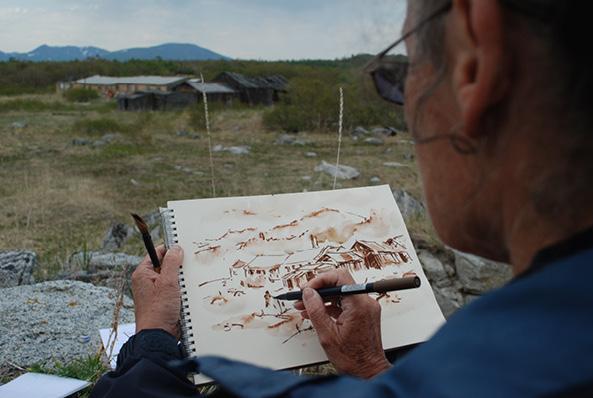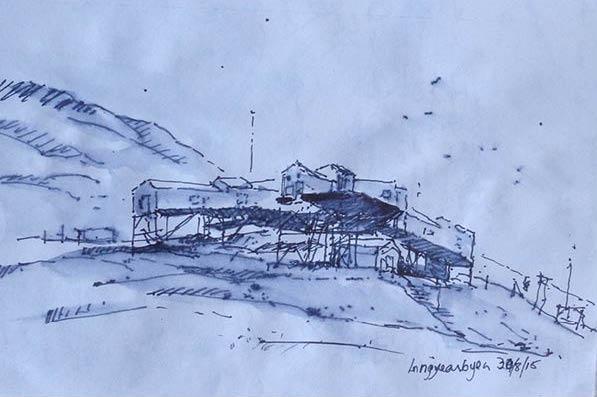Communicating ice through art

"Art can be a powerful tool in environmental education and for firing up people’s passion about environmental conservation", says Alison Wiklund. The Finnish artist’s latest project aims at processing garbage in the Russian Arctic through ‘creative recycling’, which “can wake up youngsters very quickly."
Alison Wiklunds ambition is to demonstrate the need for environmental protection through art, which transcends political, religious and cultural barriers. Wiklund has developed a variety of environmental education programs to teach young people to observe and appreciate their natural environment and to actively engage them as artists, scientists or conservationists.
She exhibited her paintings at the Arctic Circle Assembly in Reykjavik this October, and for next year’s Arctic Circle Assembly, she proposes an Arctic Circle Art Competition (ACAC), where the best young artists from the Arctic region would exhibit their art-works.
Creative garbage recycling
As Artist-in-residence on six of the voyages of Heritage Expeditions, she collected various impressions of the Russian Far East from 2009 to 2012. Some of her paintings depict garbage in the midst of beautiful scenery in the Arctic to point out the misfit, such as a ship wreck that had been washed 400 km inland on the Anadyr river bank, or an abandoned and decrepit military outpost at Cape Dezhnev in Chukotka.
In an ornithological sanctuary in Kolyuchinskaya inlet, empty oil barrels dot the landscape, which is the home of several endangered bird species such as the Spoon-billed sandpiper that breeds in Chukotka. Rusting detritus is scattered along the entire shore-line of the Russian Arctic, from Murmansk to Chukotka.

Provide economic alternatives
"What I’m now trying to find is an investor or legislator, who has a vision and wants to leave a legacy", Wiklund asserts.
The oil barrels could be used as art materials and be made into a sculpture, the ship wreck could serve as museum or other building, or its materials could be recycled and re-used. Here, her concerns for the well-being of Arctic ethnic minority groups come into play:
"If you ask young people from a disadvantaged background to respect the environment, you have to provide economic alternatives."
In an ongoing project in Malawi, Southern Africa, she has taught youngsters how to do arts and crafts from materials by gathering them from nature or by recycling garbage.
Communicating Arctic change
Another example of artistic ambitions to communicate environmental issues such as climate change in the Arctic to a wider audience is James Balog’s acclaimed documentary "Chasing Ice", which is based on the long-term research program "Extreme Ice Survey" (EIS) of documenting the melting of different ice sheets and glaciers with photographs and videos. This movie was also shown at the Arctic Circle Assembly.
Elizabeth Ogilvie, a Scottish artist aiming at fusing art and science, presented her work on the melting of the Arctic sea ice, titled "Out of Ice – The Secret Language of Ice". The art installation of melting ice cubes symbolizing a melting Arctic takes a more experiential approach, using water as medium and subject. Once the ice cubes are melted away, they are replaced by new ones "to symbolize the possible positive changes" and "showing participants that their actions really matter."
"An Arctic literacy test" for decision-makers
Níels Einarsson, Director of the Stefansson Arctic Institute in Iceland, sees art as a way to "reconcile the different perceptions of the Arctic region" and to inform people. He explains:
"Artistic expressions can help us to comprehend a complex process, including environmental change in the Arctic and how it is perceived by different stakeholders."
Einarsson argues: "There is the need to educate people in the south, whose work and decision-making impact people in the north. There should be an Arctic literacy test for people who have substantial standing in Arctic decision-making."
An anecdote from his experience speaks volumes: decision-makers on Arctic issues, who could not answer the question why polar bears do not eat penguins. The understanding of the same region sometimes seems poles apart.
